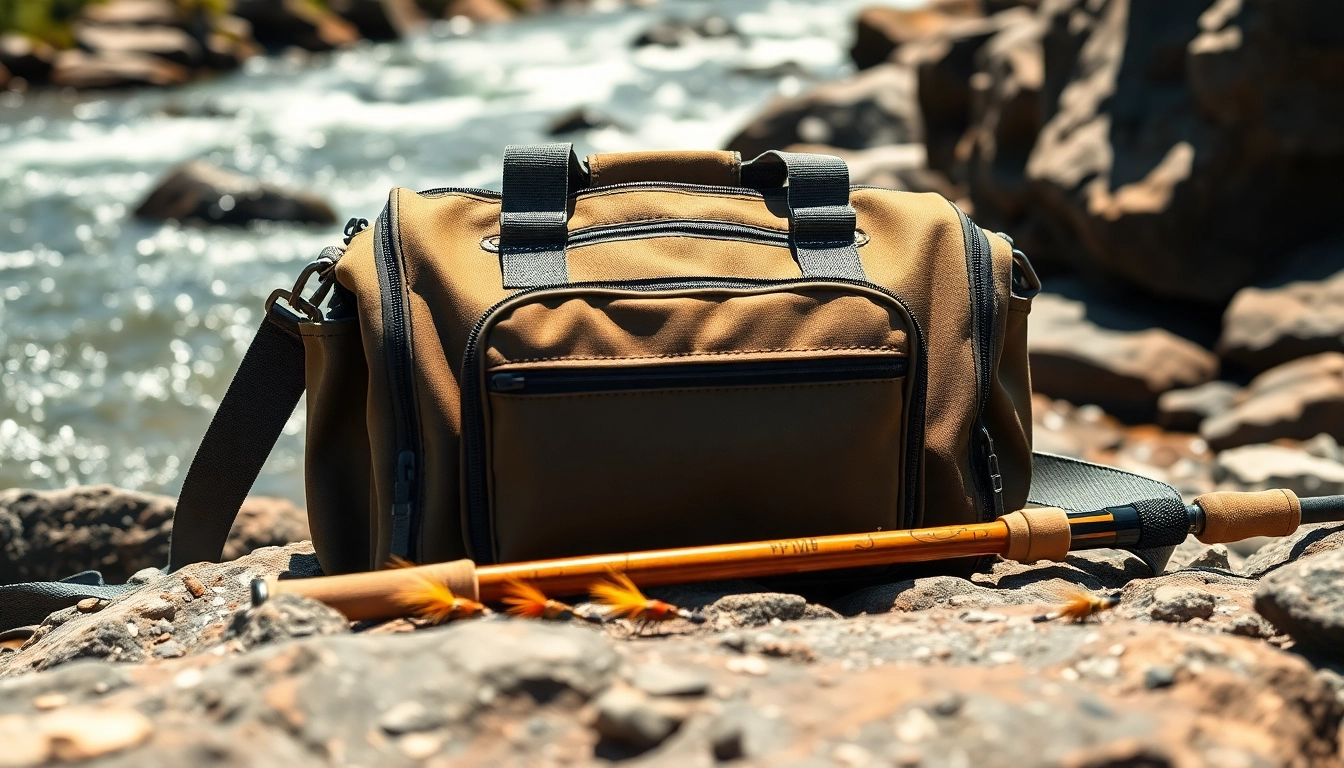Understanding the Importance of a Fly Fishing Bag
When it comes to fly fishing, having the right gear is essential for a successful and enjoyable experience. Among this gear, a vital yet often overlooked component is the fly fishing bag. This specialized bag serves as an angler’s storage and organization system, ensuring that all necessary equipment is easily accessible during outings. But what makes a fly fishing bag indispensable, and how can it truly enhance your fishing adventures? Let’s dive in.
Why Every Angler Needs a Fly Fishing Bag
A fly fishing bag is more than just a carrying case; it’s a well-structured environment for your gear. Each angler has unique needs, depending on their fishing style, preferences, and the locations they frequent. For example, a fly fishing bag provides compartments to separate fly boxes, leaders, tippets, and other essentials. Without proper organization, an angler may face frustration fidgeting with tangled lines and disorganized materials.
Moreover, having a designated bag fosters good fishing habits by encouraging careful selection and packing of gear. This practice can lead to better preparedness, resulting in a more productive trip. Whether wading into a stream or fishing from a boat, a fly fishing bag positions you for success by keeping your equipment within easy reach.
Key Features to Look For in a Fly Fishing Bag
When choosing a fly fishing bag, several key features can enhance your experience. First and foremost, consider the number of compartments and pockets. A well-designed bag will include adjustable dividers, allowing customization based on your specific gear layout. Second, durability is crucial; the bag should be made from high-quality, water-resistant materials to withstand the elements.
Additional features to look for include:
- Padded straps: To ensure comfort when carrying the bag for extended periods.
- Cushioned areas: For protecting fragile items such as reels and electronic devices.
- External attachment points: For additional items, including water bottles or nets.
- Reflective elements: For visibility in low-light conditions, keeping safety a priority.
How a Fly Fishing Bag Enhances Your Fishing Experience
A well-chosen fly fishing bag enhances your fishing experience in numerous ways. It provides a sense of organization, which can promote efficiency on the water. For instance, when all your materials are sorted and easy to find, you can quickly change flies or retrieve tools without losing fishing time.
Additionally, a thoughtfully designed bag can lighten the load of carrying bulky gear. With distribution engineered for weight management, you’ll find it easier to navigate through tougher terrains or longer hikes. This focus on comfort and convenience ultimately leads to more time spent fishing and enjoying the great outdoors.
Types of Fly Fishing Bags
Fly fishing bags come in various styles, each with distinct advantages. Understanding these types will help you find the perfect bag tailored to your needs.
Backpacks vs. Sling Bags: Pros and Cons
When evaluating fly fishing bags, the two most common types are backpacks and sling bags. Each type has its own set of pros and cons, which can greatly influence your decision.
Sling bags are designed for easy access and mobility. They can be quickly rotated from back to front without fully removing the bag, making it easy to reach for gear while on the move. However, they may lack the extensive storage capacity that backpacks offer.
On the other hand, backpacks have a larger storage capacity, making them ideal for longer trips or when transporting extra gear. They evenly distribute weight across your back, making them comfortable to carry over long distances. However, accessing specific items can require removing the bag or digging through several compartments, which may hinder efficiency during tasks that require fast adjustments, such as changing flies on a busy day.
Essential Features of Waterproof Fly Fishing Bags
Waterproof features in a fly fishing bag can prove to be a lifesaver for anglers. Being out on the water presents constant exposure to wet environments, whether from rain or splashes while casting. A waterproof fly fishing bag ensures that all of your gear remains dry and protected, minimizing the risk of equipment damage.
Key characteristics of a waterproof fly fishing bag include:
- Sealed seams: Prevent water from entering through stitching.
- Water-resistant zippers: Offer an extra level of protection against moisture.
- Durable exterior materials: Often made from synthetic materials that repel water.
Investing in a waterproof option is essential if you plan to fish in unpredictable weather or navigate through marshy or wet areas.
Lightweight Fly Fishing Bags for Easier Transport
Another factor to consider is the weight of the fly fishing bag itself. Lightweight options are particularly important for anglers who need to carry their gear over long distances or uneven terrain. Modern materials allow manufacturers to construct bags that provide ample storage without adding unnecessary weight, thus enhancing mobility.
While lightweight designs optimize transport, it is essential not to compromising on durability. Look for bags made of high-strength, lightweight fabrics that can withstand daily wear and tear while keeping the overall weight manageable.
Choosing the Right Size Fly Fishing Bag
The size of your fly fishing bag directly impacts how you manage your gear on the water. Having the right size is not merely about fitting your items; it significantly influences mobility, organization, and comfort during your fishing outings.
Assessing Your Gear Needs
Before committing to a fly fishing bag, it’s critical to assess your gear needs thoroughly. Take inventory of the equipment you typically bring along, including rods, reels, fly boxes, tools, and personal items such as snacks or a first aid kit. Understanding your needs will help you choose a bag that accommodates all necessary equipment without excess bulk.
How Size Impacts Mobility on the Water
The size of your fly fishing bag can greatly affect your mobility on the water. A bag that is too large can be cumbersome, making it difficult to navigate through dense foliage or rocky terrain. Conversely, a bag that is too small can lead to poor organization and accessibility on the water.
It’s essential to find a balance between adequate storage and weight. Test different bags while standing or walking to determine which size feels most comfortable and practical during actual fishing scenarios.
Tips for Packing Efficiently in Your Fly Fishing Bag
Efficient packing can significantly improve your experience on the water. Here are some tips for optimizing your fly fishing bag:
- Group similar items together: Keep flies with flies, tools with tools, and so on.
- Use waterproof bags: Protect sensitive items like electronics or clothing.
- Make use of every pocket: Don’t let smaller compartments go to waste; utilize them for small items like tippet spools.
- Create a gear checklist: Before leaving, review what’s packed to ensure you have everything you need.
Maintaining Your Fly Fishing Bag
To get the most out of your fly fishing bag, proper maintenance is essential. Regular care can extend its life and ensure your gear stays protected season after season.
Cleaning and Care Tips for Longevity
Cleaning your fly fishing bag regularly helps prevent dirt and grime buildup. Most bags can be cleaned with mild soap and water. Focus on hard-to-reach areas where debris may accumulate. Avoid harsh chemicals that could damage materials.
After cleaning, allow the bag to air dry completely before storing. This practice helps prevent mold and mildew, which can occur in damp conditions.
Repairing Common Wear and Tear
Even the most durable fly fishing bags can succumb to wear and tear over time. Common issues include frayed straps, broken zippers, and damaged compartments. For minor repairs, consider keeping a standard sewing kit handy for quick fixes.
For more serious repairs, such as zippers or structural damage, consult a professional repair service specializing in outdoor gear. Keeping your bag in excellent condition will ensure you’re always ready for your next fishing adventure.
Storing Your Fly Fishing Bag Properly
When not in use, storing your fly fishing bag correctly can help preserve its integrity. Avoid folding or compressing the bag, as this can result in creases and compromise structural integrity. Instead, store it in a cool, dry place, and keep it away from direct sunlight that can fade materials over time.
Ideally, hang your bag on a wall hook or place it on a shelf to maintain its shape, keeping compartments open for airflow and preventing odor buildup.
Innovative Features in Modern Fly Fishing Bags
The advancements in technology and design have led to the creation of fly fishing bags with innovative features that can make fishing even more enjoyable. When searching for the ideal bag, it’s worth examining modern offerings.
Incorporating Technology for Smart Fishing
Some contemporary fly fishing bags are now equipped with technology to aid anglers. Features like integrated solar panels allow for charging devices while on the water, enhancing your experience by keeping your gear powered. Additionally, some bags are designed with RFID technology for securing keys and wallets, reducing the chances of losing personal items.
Customizable Options for Personalization
Customizability in fly fishing bags is increasingly popular, giving anglers the ability to choose colors, patterns, and even select compartments based on their fishing style. This personalization not only allows for a unique aesthetic but also facilitates the organization according to personal preferences.
Reviewing the Latest Trends in Fly Fishing Bags
As the fly fishing industry evolves, so do the trends surrounding fly fishing bags. Sustainable materials are becoming a focal point with many manufacturers opting for recycled fabrics and environmentally friendly production methods. This shift not only benefits the environment but also meets the growing demand from eco-conscious anglers.
Additionally, bags incorporating multi-functionality—acting as backpacks, sling bags, and hip packs simultaneously—are gaining traction. These versatile designs cater to varying fishing styles and preferences while maximizing utility.



